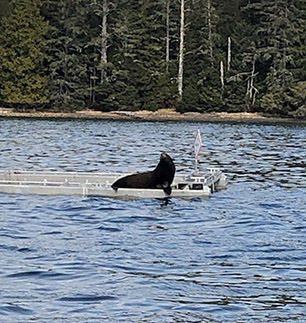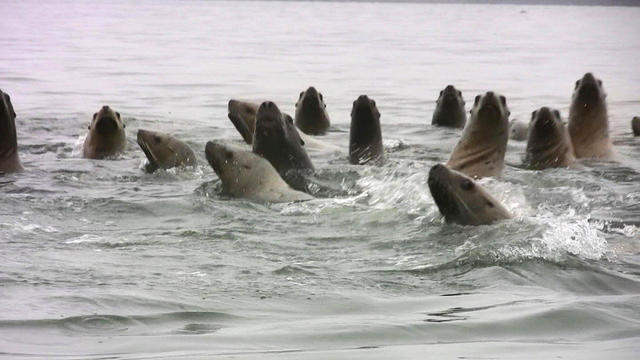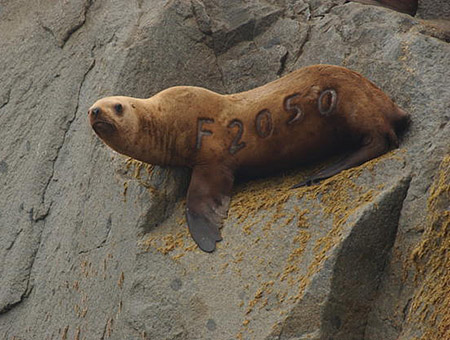Alaska Fish & Wildlife News
May 2020
California Sea Lion in Alaska

A California sea lion traded the warmer waters of Southern California for the chilly but herring-rich waters of Southeast Alaska this spring, a swim of about 2,000 miles.
Alaska fishermen working the herring roe on kelp fishery near Craig, Alaska, documented the big adult male in mid-April, 2020. His identity as a native of the Los Angeles area was confirmed by the number 9039 on his left side. He was marked by federal marine mammal researchers as a pup at San Miguel Island in in the California Channel Islands on Sept. 25, 2006. The Channel Islands are off the coast of Southern California northwest of Los Angeles.
Robert DeLong is a marine mammal researcher with NOAA (National Oceanic and Atmospheric Administration). He wrote: “At time of marking he weighed 17.6 kg and was 96 cm in length. He should be full grown at age 13+.”
Steller sea lions are common in Southeast Alaska waters, but California sea lions are relatively rare. Adult male California sea lions like 9039 average about 800 pounds. That’s a bit larger than an adult female Steller sea lion, but half the size of a full-grown adult male Steller.

DeLong provided a re-sight history of 9039. It seems this is the first time this particular animal has visited Alaska, although it’s not uncommon for California sea lions from the Channel Islands to travel the west coast. DeLong wrote: “Each year territorial males leave the California Channel Island rookeries in August and move north to Northern California through Southeast Alaska. They actively pursue concentrations of energy rich (spawning) prey, beginning with salmon in September, market squid in December in inland waters of Washington, Eulachon in January-April (Columbia River to Alaska and herring in December-April (San Francisco Bay to Alaska), before beginning southern migration back to the rookeries in May of each year.”
The re-sight history indicates 9039 frequently traveled about 300 miles north of his birthplace and home at San Miguel Island (SMI) to Año Nuevo Island in central California between Santa Cruz and San Francisco. He was re-sighted in 2007, 2008, and 2010 at Año Nuevo Island in central California. Back at SMI in 2011-2015, 2017, and 2019. He was a territorial male from 2016 through 2019 at San Miguel Island.

He was not re-sighted north of California until he was seen in Southeast Alaska in 2020.
Sea lions mate in the spring. An adult male establishes and defends a territory (hence the term, territorial male) at an established breeding site known as a rookery, like the one at San Miguel Island, and the same rookeries are used year after year.
Fishery biologist Bo Meredith, based in Ketchikan, said California sea lions are occasional visitors to Southeast. “I saw two last year in Craig,” he said. “They’re easily identifiable, they look so different.”
Steller sea lions look tan or brown when wet, whereas California sea lions look black. The facial profiles of the two are also quite different – California sea lions have a more tapered snout and a high forehead.
Researchers mark animals to learn about their movements, their fidelity (loyalty) to areas, and their reproductive and life history. Marked Steller sea lions in Alaska have provided a wealth of such information. California sea lion researchers with NOAA are looking at the animals’ diet and foraging ecology, distribution and movements/migrations, threats such as disease, contaminants and entanglement, and their genetics.

In Alaska, researchers have marked a number of Steller sea lions for similar purposes. Some animals have been equipped with GPS tracking devices that provide far more information and don’t require re-sighting.
There are five genetically distinct populations of California sea lions, one in waters off Southern California, and four in Mexican waters – one off the west coast of the Baja Peninsula and three on the other side of the peninsula in the Gulf of California. California sea lion 9039 belongs to the U.S. population.
Males migrate those long distances from the colonies during the winter whereas females and juveniles remain close the breeding areas.
A short video of 9039 near Craig.
Subscribe to be notified about new issues
Receive a monthly notice about new issues and articles.
